How to set up sFTP for using Certificate Authentication on Linux
These instructions apply to users who are receiving their statements via sFTP. If you elected to receive your statements via sFTP, you would first need to generate an RSA Key pair.
There are many Linux distributions and there are multiple methods to access the IBKR sFTP server. sFTP clients such as Filezilla can be used. In this article we explain how to realize the connection to the IBKR FTP server using Ubuntu Linux and Filezilla.
1. On your Linux machine, click on the Applications icon in the bottom left corner of you screen.



4. Once the software installation is complete, type puttygen -t rsa -b 2048 -o privatekey.ppk in order to generate the RSA Key pair.



8. Click on the FileZilla top menu File -> Site Manager...


- Select SFTP - SSH File Transfer Protocol as Protocol
- Enter xfer.interactivebrokers.com in the Host field
- Enter 32 in the Port field
- Select Key file as Logon Type
- Enter the username provided to you by Interactive Brokers in the User field
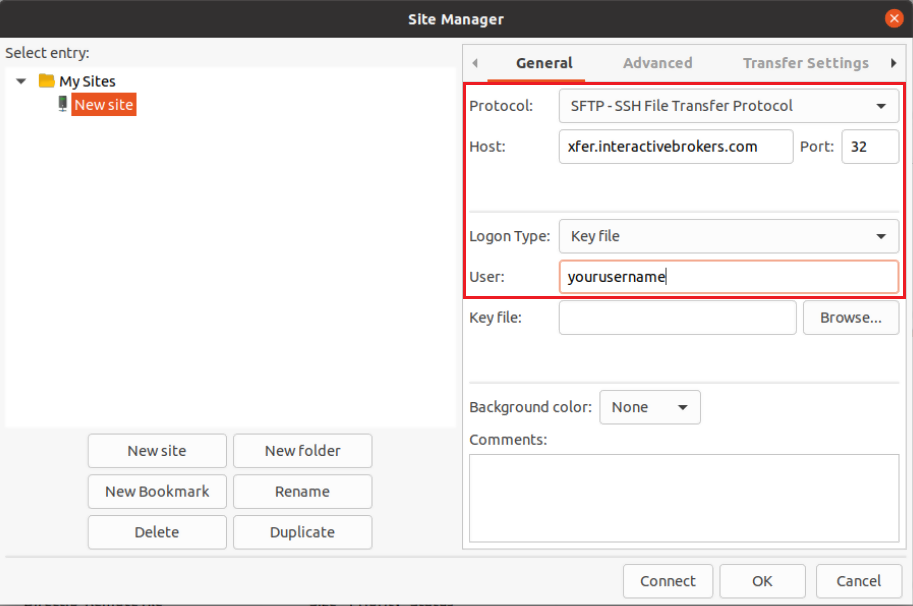





Important Note: do NOT send us your private key. Send us only your public one

Once IBKR has configured the parameters for your connection on our servers, you will be notified. After that, you will be able to access your sFTP repository by using the Site connection you have created in FileZilla. In case you have not yet set up a Site connection, please follow the steps from 6. to 14. which are a prerequisite to the below steps:



Common issues and solutions
-
Ensure the correct login details are being used to connect to the sFTP server. The username and password you are entering should match the ones you have received from the Reporting Integration Team.
-
Confirm you have configured your sFTP Client to use the Private Key file for the logon authentication (see steps 9. and 10. of the above procedure.)
-
Try accessing the sFTP server using a different Client (CyberDuck, ect.)
-
Ensure the Private Key file being used to Authenticate the server login attempt is related to the Public Key you originally sent to the Reporting Integration Team.
-
Should the above checks be unable to resolve the issue, please generate a new RSA Public/Private Key pair and send only the Public part to the Reporting Integration Team, as per IBKB3842.
-
In case you have an antivirus or a security software installed on your machine, make sure it is not blocking the FTP connection attempt. Normally, security software allows to set up exceptions for specific connections in order to whitelist them.
-
Verify that the public IP Address of the machine running the sFTP client, is the same you have originally provided to the Reporting Integration Team for being whitelisted. You can discover your public IP Address by searching the Internet for “what is my IP”. If your current IP Address is not the same you provided to us, please send it to our Reporting Integration Team for being whitelisted.
-
Ask your network administrator/s to confirm that your firewall allows both incoming and outgoing traffic from/to xfer.interactivebrokers.com on port TCP 32.
-
Should the above steps be unable to resolve the issue, please generate a new RSA Public/Private Key pair and send only the new Public part to our Reporting Integration Team, as per IBKB3842.
KB3968 - Generate a key pair using GPG for Windows
KB4205 - Generate a key pair using GPG Suite on macOS
KB4108 - Decrypt your Reports using GPG for Windows
KB4210 - Decrypting Reports using your PGP Key pair on macOS
KB4407 - Generate RSA Key Pair on Windows
KB4410 - How to set up sFTP for using Certificate Authentication on macOS
KB4411 - How to backup your public/private Key pair
KB4323 - How to transfer your public/private key pair from one computer to another
Exchange name change
Overview:
Interactive Brokers is completing an effort to update and consolidate exchange names where appropriate. When this effort is complete, the following updates will be in effect:
- GLOBEX and CMECRYPTO will be consolidated to a single exchange, ‘CME’
- ECBOT will be updated to ‘CBOT’
- COMEX listed metals (previously reflected as NYMEX) will be updated to exchange ‘COMEX’
- NYMEX, no change
Given the breadth of products involved, we are migrating in four waves based on underlying products:
| Key | Effective Trade Date | Products |
| Wave 1 | October 30, 2022 | GLOBEX: ZAR, LB, DA, IXE |
| Wave 2 | November 6, 2022 | GLOBEX: EMD, BRE, CHF, SOFR3, E7, NKD CMECRYPTO: BTCEURRR, ETHEURRR, MET |
| Wave 3 | November 13, 2022 | GLOBEX: All remaining products CMECRYPTO: All remaining products ECBOT: ZO, ZR, 2YY, 30Y NYMEX: ALI, QI, QC |
| Wave 4 | December 4, 2022 | ECBOT: All remaining products NYMEX: All remaining "Metal" products |
I am trading via API, how does this impact me?
For API clients the only requirement would be to provide a new exchange name, for example: exchange=”CME”, for existing contracts for the affected exchanges.
Old exchanges names will no longer be available after the change.
More details can be found within our FAQs through the following link: Upcoming Exchange name Changes
Note: If you are using a third party software connected to TWS or IB Gateway and that software does not recognize the new contract definitions, please contact the third party vendor directly.
Come caricare un pacchetto di dati diagnostici attraverso una piattaforma di IBKR
Vi sono dei problemi di cui si occupa l’Assistenza che richiedono il ricorso a file di log e diagnostica insieme agli screenshot. Questo tipo di informazioni sarà utilissimo e aiuterà il nostro team ad analizzare e risolvere il problema che stai avendo.
Il presente articolo serve a illustrare in maniera dettagliata i passaggi da seguire per caricare i file di diagnostica e i log relativi alle varie piattaforme di trading di Interactive Brokers.
Nota bene: nel corso della giornata IBKR non monitora il repertorio relativo al pacchetto dei dati di diagnostica. Nel caso in cui tu decida spontaneamente di caricare il pacchetto diagnostico, senza aver ricevuto istruzioni da Interactive Brokers, ti preghiamo di informare il Servizio Clienti attraverso un ticket del Centro Messaggi oppure tramite una chiamata telefonica altrimenti il tuo report relativo agli errori non verrà preso in considerazione.
In base alla piattaforma che utilizzi, clicca su uno dei seguenti link:
-
IBKR Mobile (Android)
-
IBKR Mobile (iOS)
- Per i sistemi operativi Windows e Linux: premi Ctrl+Alt+Q
- Per Mac: premi Cmd+Option+H















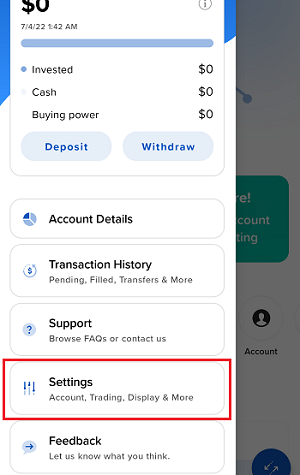




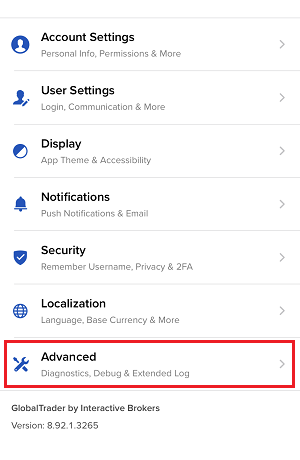

7. Inserisci i tuoi commenti nel campo e premi su “Allega immagine” per inserire gli screenshot del problema che avrai avuto cura di salvare in precedenza nella cartella della tua Fotocamera

È possibile realizzare una traccia diagnostica per il Portale seguendo le istruzioni riportate nell’articolo IBKB3512
Come generare un file ".har"
Talvolta, per risolvere problemi nel caso di difficoltà gravi legate al sito web, il nostro team del Servizio Clienti potrà richiederti alcune informazioni aggiuntive relative circa le comunicazioni del tuo browser. Ti verrà richiesto di registrare e fornire un file nel formato ".har". Questo tipo di file contiene informazioni aggiuntive circa le richieste di rete che vengono inviate e ricevute dal tuo browser. Il browser può generare questo tipo di file che registra il contenuto, la timeline e lo status delle richieste e risposte http/HTTPS al momento in cui queste sono avvenute.
In questo articolo spieghiamo come generare un file nel formato ".har". Clicca su uno dei link qui in basso a seconda del browser che utilizzi di solito:
Generare un file HAR con Google Chrome:
1. Apri Google Chrome e vai alla pagina nella quale si verifica il problema.
2. Premi CRTL +SHIFT + I sulla tua tastiera. In alternativa, clicca sull’icona del menu Chrome (i tre puntini verticali nell’angolo in alto a destra nella finestra del browser) e seleziona Altri Strumenti > Strumenti per Sviluppatori
3. Selezionando gli Strumenti per Sviluppatori comparirà un pannello nella parte inferiore (o laterale) dello schermo. Seleziona la scheda Rete (Figura 1.)
Figura 1
.png)
4. Cerca il pulsante rotondo Registra nell’angolo in alto a sinistra nella barra degli strumenti disponibili fra gli Strumenti per Sviluppatori e assicurati che la luce sia rossa. Se la luce è grigia, clicca sul pulsante per avviare la registrazione oppure premi CTRL+E (Figura 2.)
Figura 2

5. Attiva la casella Conserva registro (Figura 3)
Figura 3
.png)
6. Clicca sul pulsante Cancella per cancellare i registri esistenti nella scheda. Il pulsante Cancella è quello con l'immagine del simbolo segnaletico del "divieto" e si trova a destra del pulsante Registra (Figura 4.)
Figura 4.

7. Riproduci il problema che hai riscontrato mentre le richieste della rete vengono registrate.
8. Riproduci il problema riscontrato, fai clic destro ovunque nella lista delle richieste di rete registrate, seleziona Salva tutto come HAR con contenuto. Quindi salva il file nella destinazione che preferisci sul tuo computer (ad es. sul Desktop).
9. Dal Portale Clienti di IBKR, vai nel Centro Messaggi e crea un nuovo Ticket Web (oppure potrai utilizzare un ticket esistente).
10. All'interno del Ticket Web potrai allegare il file .har che hai generato. Nel caso in cui il Servizio Clienti di IBKR ti abbia fornito un numero di riferimento oppure il nome di un responsabile, ti invitiamo a inserire queste informazioni nel testo del ticket.
11. Invia il Ticket Web.
Generare un file HAR con Firefox:
1. Apri Firefox e vai alla pagina nella quale si verifica il problema.
2. Premi F12 sulla tua tastiera. In alternativa, clicca sull’icona del menu di Firefox (tre linee orizzontali parallele nell’angolo in alto a destra nella finestra del tuo browser), quindi seleziona Sviluppo Web > Rete
3. Selezionando gli Strumenti per Sviluppatori comparirà un pannello nella parte inferiore (o laterale) dello schermo di Firefox. Seleziona la scheda Rete (Figura 5.)
Figura 5.

4. Attiva la casella Conserva registro (Figura 6.)
Figura 6.

5. Riproduci il problema che hai riscontrato. La registrazione delle richieste di rete si avvierà in automatico.
6. Una volta riprodotto il problema, fai clic destro ovunque nell’elenco delle richieste registrate e seleziona Salva Tutto come HAR
7. Quindi salva il file nella destinazione che preferisci sul tuo computer (ad es. sul Desktop)
8. Dal Portale Clienti di IBKR, vai nel Centro Messaggi e crea un nuovo Ticket Web (oppure potrai utilizzare un ticket esistente).
9. All'interno del Ticket Web potrai allegare il file .har che hai generato. Nel caso in cui il Servizio Clienti di IBKR ti abbia fornito un numero di riferimento oppure il nome di un responsabile, ti invitiamo a inserire queste informazioni nel testo del ticket.
10. Invia il Ticket Web.
Generare un file HAR con Microsoft Edge:
1. Apri Edge e vai alla pagina nella quale si verifica il problema.
2. Premi F12 sulla tua tastiera. In alternativa, clicca sull’icona del menu di Edge (i tre puntini orizzontali nell’angolo in alto a destra nella finestra del browser) e seleziona Altri Strumenti > Strumenti per Sviluppatori
3. Clicca sulla scheda Rete (Figura 10.)
Figura 10.
.png)
4. Riproduci il problema che hai riscontrato mentre le richieste della rete vengono registrate.
5. Una volta finito, clicca sull’icona del floppy disk (Esporta come HAR) oppure premi CTRL+S (Figura 11.)
Figura 11.

6. Indica il nome del file e quale sia la destinazione che preferisci (per esempio sul Desktop). Quindi clicca sul pulsante Salva.
7. Dal Portale Clienti di IBKR, vai nel "Centro Messaggi" e crea un nuovo Ticket Web (oppure potrai utilizzare un ticket esistente).
8. All'interno del Ticket Web potrai allegare il file .har che hai generato. Nel caso in cui il Servizio Clienti di IBKR ti abbia fornito un numero di riferimento oppure il nome di un responsabile, ti invitiamo a inserire queste informazioni nel testo del ticket.
9. Invia il Ticket Web.
Generare un file HAR con Safari:
Nota bene: Prima di generare un file HAR, assicurati di poter visualizzare il menu Sviluppo in Safari. Se non vedi questo menu, clicca sul menu di Safari, scegli Preferenze, vai sulla scheda Avanzate e attiva la casella a fianco alla dicitura Mostra menu Sviluppo nella barra dei menu
1. Apri il menu Sviluppo e seleziona Mostra Web Inspector oppure premi CMD+ALT+I
2. Clicca sulla scheda Rete (Figura 12.)
Figura 12.

3. Attiva la casella Conserva registro (Figura 13.)
Figura 13.
.png)
4. Clicca sull'icona Esporta (oppure premi CMD+S), indica il nome e la destinazione del file sul tuo computer (ad es. sul Desktop). Salva il file in formato ".har"
5. Dal Portale Clienti di IBKR, vai nel "Centro Messaggi" e crea un nuovo Ticket Web (oppure potrai utilizzare un ticket esistente).
6. All'interno del Ticket Web potrai allegare il file .har che hai generato. Nel caso in cui il Servizio Clienti di IBKR ti abbia fornito un numero di riferimento oppure il nome di un responsabile, ti invitiamo a inserire queste informazioni nel testo del ticket.
7. Invia il Ticket Web.
How to Upload a Diagnostic Bundle from an IBKR Platform
Some support related issues require diagnostics files and logs to be uploaded along with screenshots. The information will help our team to investigate and resolve the issue that you are experiencing.
This article will help you with detailed steps on how to upload diagnostics files and logs from various Interactive Brokers’ trading platforms.
Note: IBKR does not monitor the diagnostic bundle repository throughout the day. Should you spontaneously decide to upload a diagnostic bundle, without being instructed by Interactive Brokers, please inform our Client Services via Message Center ticket or phone call otherwise your error report will go unnoticed.
Please click on one of the links below, according to the platform you are using:
-
IBKR Mobile (Android)
-
IBKR Mobile (iOS)
- For Windows and Linux Operating system: Press Ctrl+Alt+Q
- For Mac: Press Cmd+Option+H






















7. Enter your comments in the field and tap ‘Attach Image’ to attach the screenshot/s you previously saved in your camera roll

A diagnostic trace for Client Portal can be captured following the steps on IBKB3512
Generate RSA Key Pair on Windows
These instructions apply to users who are receiving their statements via sFTP. If you elected to receive your statements via sFTP, you would first need to generate an RSA Key pair.
To generate an RSA Key pair:
2. Run the installer and make sure to check PuTTYgen (key generator) as one of the components to install.
3. Start WinSCP and from the button Tools select Run PuTTYgen.

4. Once the tool PuTTYgen has been launched, click Generate. Select RSA as Type of key to generate, 2048 as Number of bits in generated key and click on the button Generate.
5. Click "Save private key" and give the file a name (like private). Leave the extension as .ppk ('ale.ppk', in the picture below is an example filename).
Important Note: do NOT save your public key yet. Save only your private one.
.png)
6. Open WinSCP, create a new connection and:
- Select SFTP as File protocol.
- Enter xfer.interactivebrokers.com in the Host name field.
- Enter 32 in the Port number field.
8. In the Advanced Site Settings screen, left side menu, expand SSH and select Authentication. Click on the button ... at the end of the field Private Key file and open the private key you previously saved at point 5):
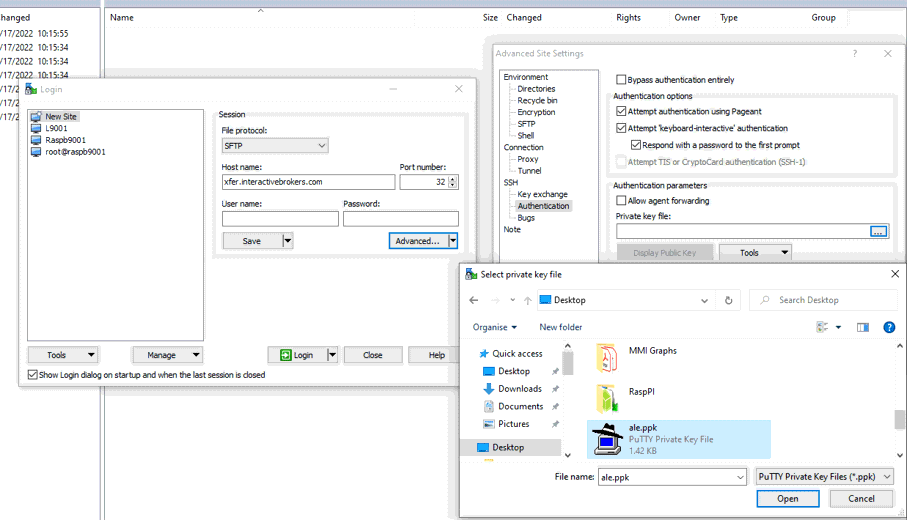
9. Click on the button Display public key:

11. Open Notepad, press CTRL+V to paste the key string (which is one string of characters without spaces) and then save the file with the name public.key in a folder of your preference:

12. Send the file you saved at the previous step to us via Message Center ticket or email as per instructions on IBKB3842
KB3842 - Using GPG/RSA encryption keys to guarantee the privacy and security of your Reports
KB3968 - Generate a key pair using GPG for Windows
KB4205 - Generate a key pair using GPG Suite on macOS
KB4108 - Decrypt your Reports using GPG for Windows
KB4210 - Decrypting Reports using your PGP Key pair on macOS
Transferring your Key Pair From One Computer To Another
If you need to decrypt files that were encrypted with your private Key on an additional computer, you need to copy both your private and public keys (the entire Key pair) to that computer.
Note: this tutorial assumes you have already set up a Key pair. If you need guidance to set up the Key pair please refer to this article, which is a prerequisite to the instructions below.
How to transfer your Key pair:
Please select one of the below links, according to your Operating System:
Windows
1. On the machine where the encryption keys are stored, connect a USB drive to a free USB port.
2. Launch the Kleopatra application and select the encryption key you want to transfer. Then right-click on the selection and choose Backup Secret Keys...
Note: Do NOT use Export..., as this will only export the public part of the Key while you need to have a backup of both public and private parts.

3. Select your USB drive as destination and a filename of your preference (e.g. secret-key-KEYID.asc) for your backup copy. Then click Save.

4. Enter the passphrase you have set when you created the Key and click OK.

5. A pop-up will confirm the backup has been successfully created. Click OK.

6. Eject your USB drive safely through the Windows interface to prevent data loss and connect it to a free USB port on the other computer (the one you want to transfer the key to). All the next steps have to be executed on that machine.
7. Make sure the the GPA software is installed, otherwise please install it. Make sure that the component Kleopatra is selected as one of the sub components to include in the installation.
8. Launch the Kleopatra application and click on the top menu File and select Import...

9. Click on the letter correspondent to your USB drive and select the file you have previously saved (e.g. secret-key-KEYID.asc). Then click Open.

10. Click on Yes, It's Mine.

11. A pop-up will confirm the Key has been successfully imported. Click OK. You may now want to delete the key file from the USB drive and empty the Trash.

macOS
1. On the machine where the encryption keys are stored, connect a USB drive to a free USB port.
2. Launch the GPG Keychain application and select the encryption key you want to transfer. Please make sure that you see the text Type: Secrete and public key, in the Type column.
.png)
3. With the desired encryption key highlighted, click Export. Please make sure to check the box for the option Include secret key in exported file, as illustrated in the above screenshot. Save the key pair to the USB drive.
4. Eject the USB drive and connect it to a free USB port on the other computer (the one you want to transfer the key to). All the next steps have to be executed on that machine.
5. Make sure the GPG Tools suite is installed, otherwise please install it.
6. Launch the GPG Keychain application and click the icon Import on the top toolbar.
(1).png)
7. Click the USB Drive and select the previously saved .ASC file that contains the Public and Private key. Then click Open.
8. The confirmation should read Import successful.

9. Once the key has been successfully imported, delete the key file from the USB drive and empty the Trash.
KB3842 - Using GPG/RSA encryption keys to guarantee the privacy and security of your Reports
KB3968 - Generate a key pair using GPG for Windows
KB4205 - Generate a key pair using GPG Suite on macOS
KB4108 - Decrypt your Reports using GPG for Windows
KB4210 - Decrypting Reports using your PGP Key pair on macOS
KB4407 - Generate RSA Key Pair on Windows
Decrypting Reports Using Your PGP Key Pair on macOS
Note: This tutorial assumes you received reports via email or via FTP that were encrypted with the public key you sent to IBKR . If you need guidance to set up the encrypted statement delivery, please refer to this article, which is a prerequisite to the instructions below.
1. Open Finder
2. Right click on the .gpg file you want to decrypt
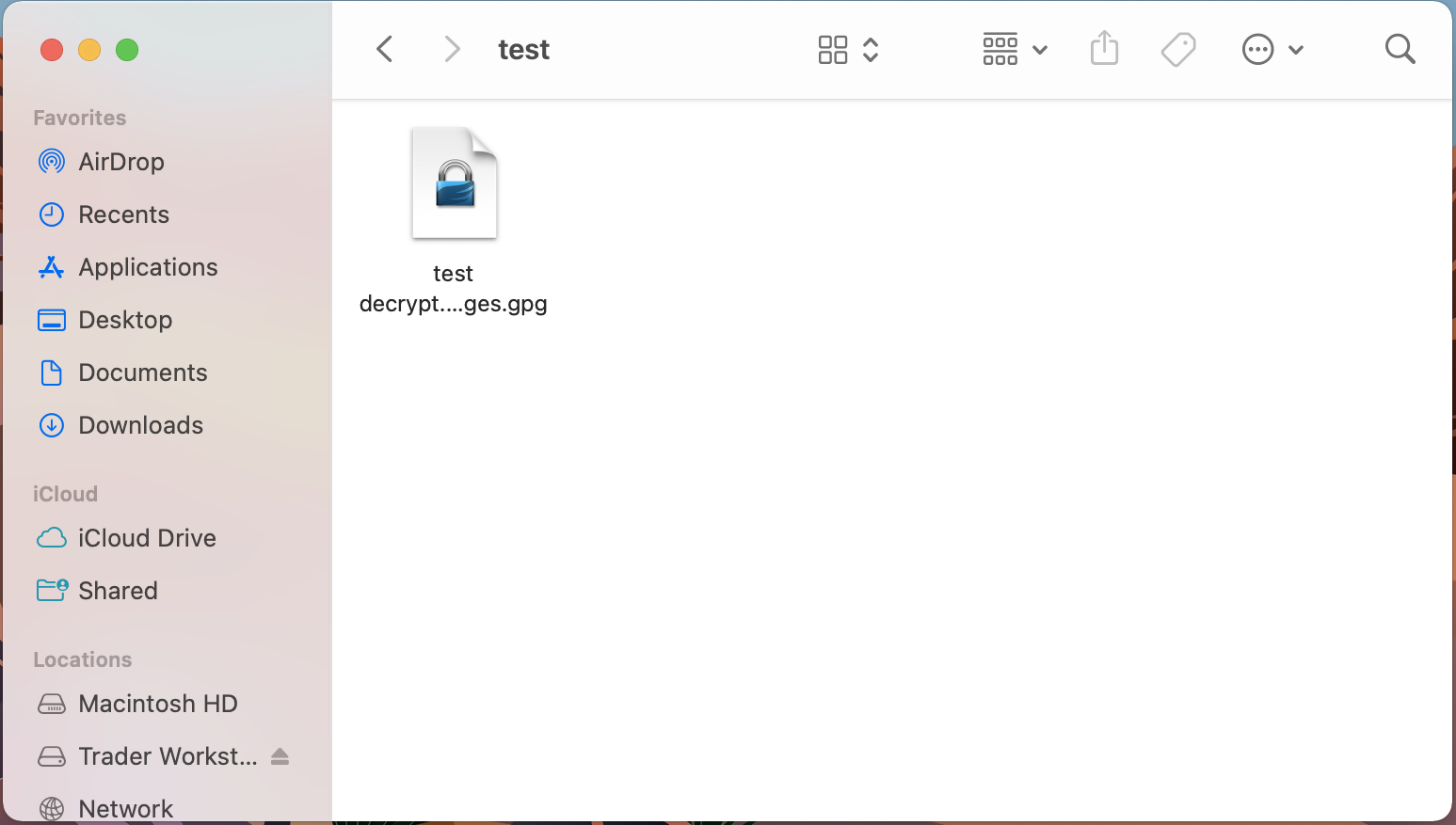
3. Select Services > OpenPGP: Decrypt File

Common Issues/Questions
- Decryption failed with error 'No Secret Key'
This is commonly caused when the wrong encryption key is used to decrypt the file. If decryption is being done on a computer other than the original computer used to create the public/private keys, the keys would have to be transferred from the original computer to the new computer.
If the above does not help, then a new public/private key pair needs to be created and sent to us.
KB3842 - Using GPG/RSA encryption keys to guarantee the privacy and security of your Reports
KB3968 - Generate a key pair using GPG for Windows
KB4205 - Generate a key pair using GPG Suite on macOS
KB4108 - Decrypt your Reports using GPG for Windows
KB4407 - Generate RSA Key Pair on Windows
Utilizzo del sistema di Autenticazione IBKR Mobile (IB Key) senza le notifiche
Nel caso in cui il tuo smartphone non possa ricevere le notifiche dall’app IBKR Mobile, potrai comunque completare la procedura di accesso al sistema di Autenticazione IBKR Mobile (IB Key) con il metodo Challenge/Risposta descritto nelle seguenti pagine (seleziona il link in base al sistema operativo del tuo dispositivo):
Lo stesso vale se il tuo telefono non ha temporaneamente la connessione a Internet (sei in modalità roaming, non hai campo, non hai un piano tariffario per telefono portatile attivo, ecc.)
Se, pur avendo la disponibilità della connessione a Internet, il tuo telefono non può ricevere le notifiche di IBKR Mobile, ti consigliamo di seguire i passaggi descritti in questo articolo presente su IBKR Knowledge Base, il nostro archivio di risorse online.
Decrypt Your Reports Using GPG for Windows
Note: This tutorial assumes you received reports via email or via FTP that were encrypted with the public key you sent to IBKR. If you need guidance to set up the encrypted statement delivery, please refer to this article, which is a prerequisite to the instructions below.
How to decrypt files using Kleopatra:
1. Save all the encrypted Reports you received via email or FTP in a folder on your preference (e.g. Desktop)
2. Start the Kleopatra application (included in Gpa4win software). The entry for your Key should be listed in the All Certificates panel. Click the top menu File and select Decrypt/Verify...





Common Issues/Questions
- Decryption failed with error 'No Secret Key'
This is usually caused by the wrong encryption key being used to decrypt the file. If decryption is being done on a computer other than the original computer used to create the public/private keys, the keys would have to be transferred from the original computer to the new computer.
If the above does not help, then a new public/private key pair needs to be created and sent to us.
KB3842 - Using GPG/RSA encryption keys to guarantee the privacy and security of your Reports
KB3968 - Generate a key pair using GPG for Windows
KB4205 - Generate a key pair using GPG Suite on macOS
KB4210 - Decrypting Reports using your PGP Key pair on macOS
KB4407 - Generate RSA Key Pair on Windows
KB4409 - How to set up sFTP for using Certificate Authentication on Windows
KB4410 - How to set up sFTP for using Certificate Authentication on macOS
KB4411 - How to backup your public/private Key pair
KB4323 - How to transfer your public/private key pair from one computer to another

